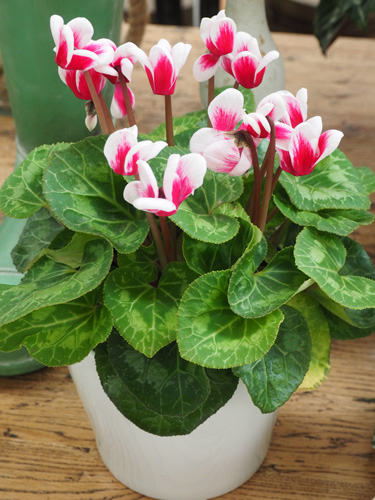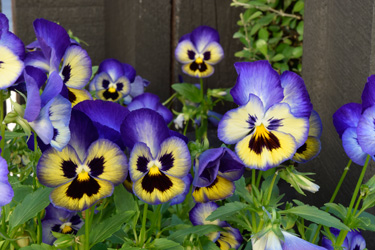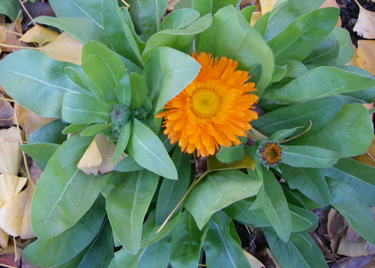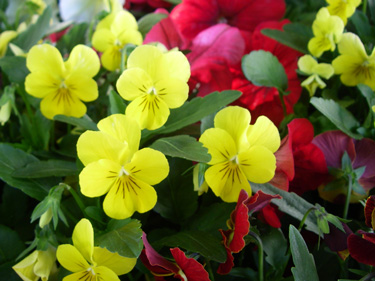Cool colour in containers
When shorter days mean less time outside it makes sense to bring nature closer – making the most of potted plants in and around the home. Container gardening is a fun all-weather activity, and having beautiful plants around us promotes a happy state of mind!
Indoors
Live plants beam life and vitality into a room at any time of year, but they’re especially important when winter has us spending most of our time inside.
Houseplants help us feel good, not just because they look great. They’re fantastic air fresheners too, scientifically proven to improve the air we breathe. The rate at which indoor plants can absorb toxic carbon dioxide and replace it with healthy oxygen has been shown to make a significant difference to the health of homes and offices.
Beautiful peace lilies (Spathiphyllum) rate highly as ‘healthy air’ plants, as do colourful crotons, cordylines and bromeliads. These easy care plants offer floral and foliage interest that lasts many years.
Loved for their stunning foliage, ferns make great indoor plants because they are naturally adapted to low light conditions. To get the best from ferns, give them pure rainwater, feed them only with diluted organic plant food and keep them away from heaters. A worn-out maidenhair fern can be given a new lease of life if it is cut right back and repotted into fresh potting mix in spring.
Fresh flowers make a room look loved in a way that fakes can never match. If you want something that lasts longer than a bunch of cut flowers, treat your home to a beautiful flowering houseplant. Make the most of the fabulous array on offer at this time of year. Elegant moth orchids and anthuriums are surprisingly easy care, and flower for many months. Cyclamen and Chrysanthemums never fail to look lovely, with a colour to suit any décor.
Outdoors
Arriving home at dusk after a wintry working day, pots of brightly coloured flowers make a welcoming scene at the front door. A flower filled patio (or just a simple bowl of freshly potted colour on an outdoor table) will draw us out into the fresh air on the weekend, even if the sun is slow to shine.
Growing plants in pots is even easier in winter than it is in summer because in winter they take a lot less watering. Now is the time to make use of those shallow pots and troughs that tend to dry out in summer. A pot filled with container mix is warmer and drier than a soggy garden border, a much more hospitable environment for young plants.
Here we list some of the all time classic winter flowering annuals. You can grow them from seed, or purchase as small seedlings in punnets, but in winter ‘potted colour’ is arguably the very best way to go. These fully grown seedlings give instant enjoyment and keep flowering throughout winter and spring. In colder weather seedlings are slower to grow, but potted colour plants come with strong, well-established roots better able to cope with transplanting and low temperatures than tiny seedlings. Because they are grown in individual pots, their roots are less likely to be damaged when you move them from their nursery pot. Best of all, you can pick out exactly the colours you want!
Quick and easy winter colour
Mini cyclamen
Mini cyclamen perform well in outdoor pots where they receive good light but protection from weather extremes such as heavy rain, hail, hot sun and frost. With attractive foliage topped with dainty flowers these dependable little perennials grow from bulb-like structures called corms. Today’s modern minis are the result of extensive breeding to develop tough, prolific and long flowering plants for autumn and winter gardens. Choose pristine white or rich lipstick tones of pink, red and purple.
Polyanthus
These perky primula cousins put on a kaleidoscope of colours and dependable flowering performance right through the cooler months. The modern poly has come a long way since the English primrose was first crossed with the cowslip. Every year it seems, plant breeders are adding new fashion colours to the mix.
Pansy
Quaint faces in just about every colour keep smiling well into summer. They’re favourites as colour accents in containers. Today’s pansy strains tolerate a wide range of temperatures. They are fantastic in pots, hanging baskets and window boxes and great with bulbs. Protect them from snails and feed them to keep the mass of flowers coming. If autumn planted pansies turn tatty, trim them back and feed them. A fresh crop of colour will soon appear.
Viola
Violas are baby pansies. They come in a myriad of colours and make fabulous companions for larger flowers, herbs, or bulbs.
Primula (Fairy primrose)
Commonly known as Fairy primrose these cold hardy plants are lovely en masse. Their feminine flowers are formed in tiered clusters on upright stems in pretty shades of pink, magenta or snow white.
Ornamental Kale
These classy cabbages are increasingly popular as winter colour. Available in gorgeous shades of pink, green and creamy white, they tone beautifully with cyclamen and primulas, whether you grow them in pots or in the garden soil. If the seedlings are planted closer together, the heads will be smaller with stems long enough for picking.
Calendula
These bright orange or yellow cool weather flowers are often planted for a splash of colour among vege plants and will and will pop up from self-sown seed in autumn (easily removed if they appear where they are not wanted). They also help repel insect pests, and their petals are edible – extra colour for salads. Easy in the garden or in containers, calendulas are a traditional cottage garden flower in England, where they are known as ‘pot marigolds’.
Iceland poppy
Elegant orange, cream, or yellow flowers are like cups of crumpled silk and held above their foliage on graceful stems. In coldest climates they are best planted in spring. The stems and flower buds are covered in silky hairs that glisten in the sun.
Plan for early spring
Pots of spring flowering bulbs light up the scene, indoors or out, in late winter and early spring. If you haven’t already done so, there’s still time to cram pots with beautiful hyacinths, tulips, freesias, bluebells and daffodils.
Winter pot tips
- Use fresh, top quality container mix, not garden soil.
- Plant generously. A full container has the most impact!
- Check drainage. Raise large pots on pot feet or bricks. Remove any saucers from outdoor plants.
- Remove spent flowers to encourage continuous flowering. If autumn planted pansies get tatty over winter, trim and feed to bring on a fresh flush of flowers.
- Most container mixes come with nutrient to last three months, but with heavy rain this may be reduced. Supplement with controlled-release or liquid fertiliser to keep flowers coming in spring.
- Pansies, primula and cyclamen will flower in part shade, but generally more sun means more flowers.
- Beware of slugs and snails. Apply slug bait if necessary.
Cyclamen care
Favourite indoor plants for winter, delicate looking cyclamen are actually very tough. They originate from Mediterranean climates where winters are cold and summers are dry.
Well lit
Place in bright indirect light, away from direct sun. An unheated room is ideal, as cool temperatures prolong flowering.
On the dry side
Keep the potting mix moist but not wet. Watering from the base of the plant, via the saucer, avoids wetting the corm, which is susceptible to disease.
Signs of stress
A yellow leaf is the first sign of too much water. If this happens, let the potting mix dry out for a couple of weeks (not to wilting stage), then resume cautious watering. A thirsty cyclamen plant will shed its lower leaves and flowers, but retains its newest leaves most vital to survival.
Grooming
Remove spent blooms by holding the stem close to its base and giving a sharp pull to break it cleanly from the corm. Decaying left over stems invite disease.
After flowering
At the end of winter the flowers and leaves die down, you can keep your cyclamen plant going if the corm is kept dry. Put the pot outdoors for summer, turned on its side. In autumn repot into fresh potting mix and resume watering. Once the leaves appear, feed fortnightly with diluted liquid fertiliser until the flower buds begin to form.
Winter Houseplant Care
Water sparingly
In winter, growth is slow so less water is needed. The potting mix should be dry on top and just moist (like a squeezed out sponge) beneath.
Warm but not too hot
Many houseplants are tropical and don’t like cold nights. Place them where there is warmth and bright light but not direct sun. Remember the sun is at a lower angle in winter. Avoid cold draughts but move them away from heaters.
Create humidity
Heaters create dry air, which many houseplants don’t like. To improve the humidity around the likes of orchids and ferns, sit plants on a dish of stones filled with water so that the pot sits just above, not in, the water.
15-Apr-2015

Polyanthus

Cyclamen

Pansies

Calendula

Violas


